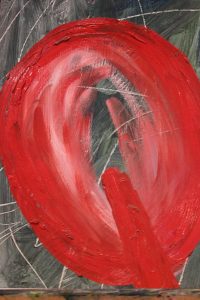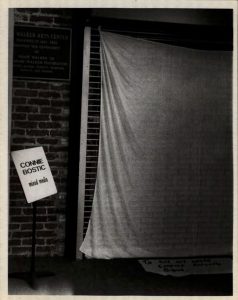In August, I started working on a semester-long studio archiving project with Connie Bostic, western NC-based painter, teacher, and woman-about-town. I first got to know Bostic in her role as a board member at the Black Mountain College Museum + Arts Center, where I worked before starting my graduate program at UNC-Chapel Hill. In the museum’s nomadic early days, Bostic’s Zone one contemporary gallery provided downtown exhibition space for the small nonprofit. Zone one, which closed in 2000, was also the first contemporary art gallery in downtown Asheville (known in its first incarnation as World Gallery).[1] This semester, my project includes inventorying the artworks and ephemera in Bostic’s studio, a renovated barn in the bucolic Fairview community outside of Asheville. I’m also doing a bit of detective work–hunting down and inventorying other works in private collections–as well as photographing a selection of the works.
Before the start of this project, I digitized a set of Bostic’s clippings from early in her career. Prominent within the collection are materials pertaining to Bostic’s 1990 MFA thesis exhibition, a set of paintings in her Mark of the Goddess series combined with quotations about women from history’s “great men”. The paintings–abstract oil on paper works–were to be exhibited in the Walker Arts Center of the Asheville School from Aug. 8 – Sept. 10, 1990. Instead, the headmaster John Tyrer
called for them to be removed almost immediately, saying “Female genitalia have no place on the walls of a school building.” Bostic’s work, intended to evoke reflection on the loss of women’s cultural heritage within history, was itself covered over and symbolically silenced, an absurdity that advocates of the exhibition’s censorship appeared to miss. The materials documenting this event include exhibition photographs, flyers and postcards, and newspaper clippings regarding the censorship and community protests and response. As I think about the role of art and its reception within a community, I find these materials to present a compelling argument for inclusion of local artists’ archives within local repositories.
Artists’ archives provide important insight not just into artists’ careers and artwork, but into histories of their communities–how they have shaped and been shaped by their homes. To explore this a bit more, my project also includes the collection of a limited set of oral histories in order to more fully document how her history and local history intertwine, as well as planning for possible institutional donation of some of her archival materials. As I’ve been exploring Bostic’s materials and hearing stories from her and the folks she’s worked with over the years, it has become clear to me that you cannot tell the history of the arts scene in Asheville, the revitalization of the downtown area, and the often fraught identity of places marketed as “arts destinations” without spotting Bostic as a key figure. Indeed, in a program series at Asheville’s Pack Library this summer, “Asheville in the 80’s,” Bostic discussed bringing works by Robert Mapplethorpe and Keith Haring to Asheville, as well as the impact of other influential figures in the arts community.
After the semester ends, I’ll post an update on my project with some lessons learned. Currently, the major quandary I face is, “How do I account for interaction?” Artists don’t work in a vacuum, and certainly not Connie. Friday mornings are a rush of activity in her studio, as Connie directs a circle of students while taking calls and answering questions and sharing gossip and preparing for the next exhibition (which opened recently as RED and is comprised mostly of large oil on canvas works demonstrating her career-long exploration of themes of womanhood and sexuality).[2] I’m finding that, in addition to her artwork and studio materials, that atmosphere is something I’d like to preserve.
And finally, the “Learning from Artists’ Archives” team has a big weekend coming up: This Saturday, October 8, we will be holding our second daylong Archiving for Artists workshop at the Mint Museum Randolph location in Charlotte, NC. This year, we’ve added sessions on intellectual property issues related to legacy planning, as well as optimizing studio archives to facilitate grantwriting, exhibition planning, and marketing. View our schedule here and stay tuned for future posts recapping the event.
Notes:
[1] Bailey, Patricia. “The End of an Era.” The Mountain Express. December 20, 2000. Accessed October 2, 2016. https://mountainx.com/arts/art-news/1220zoneone-php/\.
[2] “Flood Gallery Reopens at New Location with RED.” September 14, 2016. Accessed October 2, 2016. http://www.citizen-times.com/story/entertainment/arts/2016/09/14/flood-gallery-reopens-new-location-red/90263792/.



